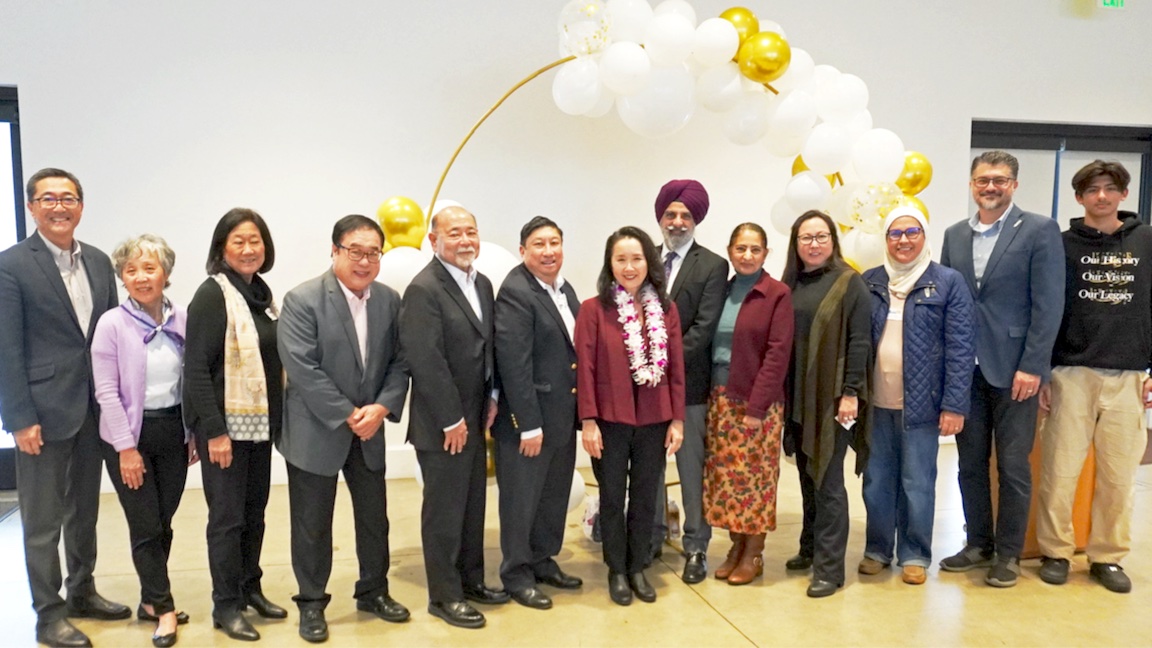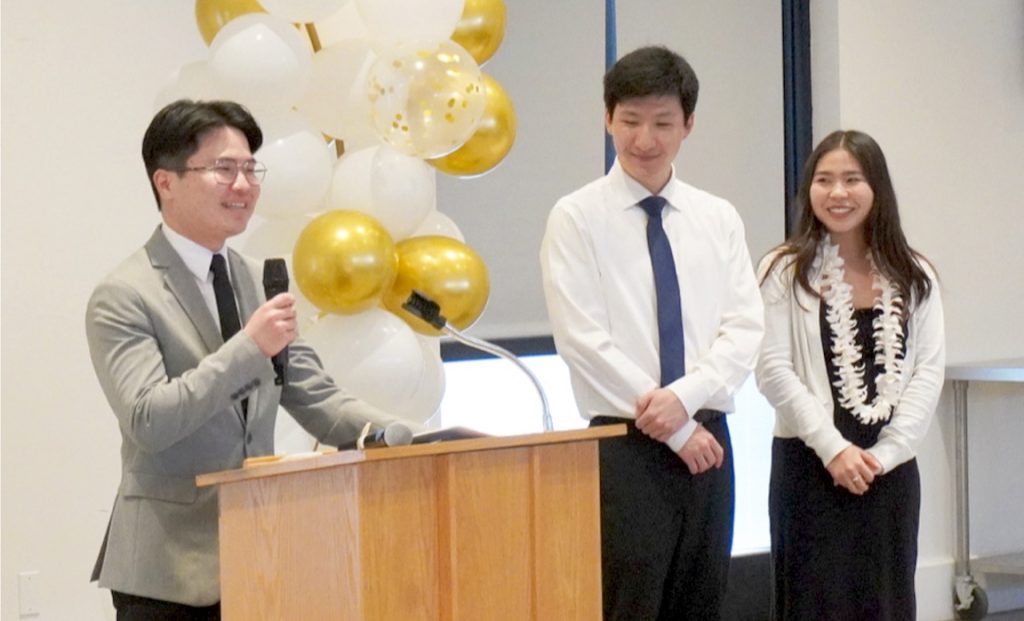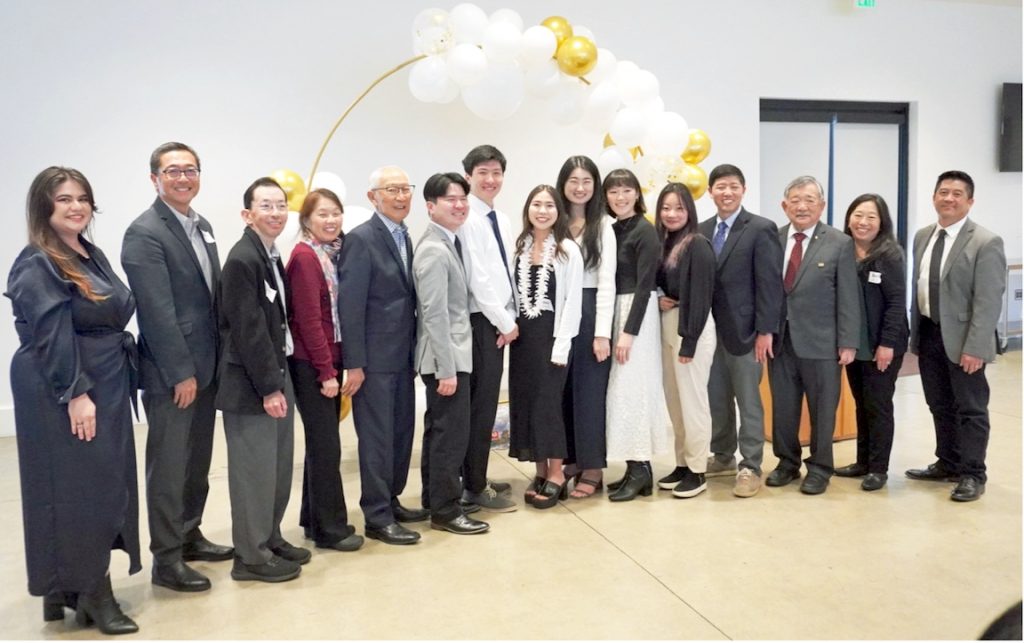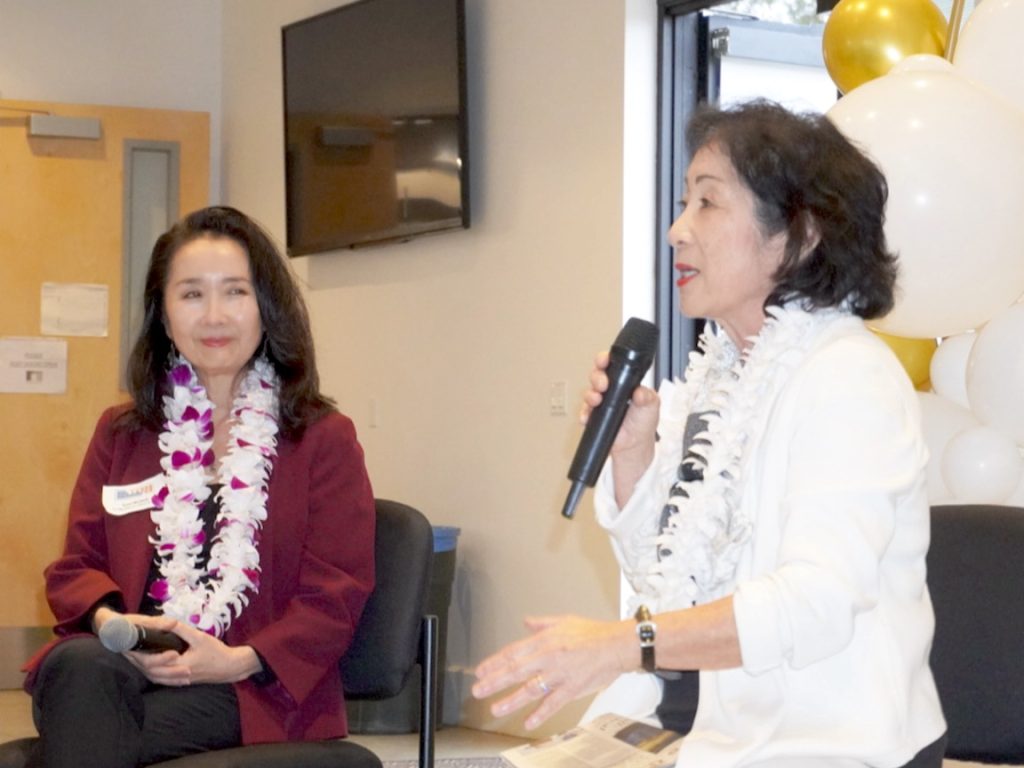
The SELANOCO/Orange County JACL installation welcomed many special guests. Pictured (from left) are George Tanaka, U.S. Bank; Susan H. Kamei, USC; Dr. Audrey Yamagata-Noji, Mt. SAC; Alan H. Woo, Santa Ana Planning Commission; Steve Tamanaha, Orange Coast College; Chancellor Dr. Whitney Yamamura, Coast Community College District; Teresa Watanabe, Los Angeles Times; Dr. Gurpreet Singh Ahuja and Dr. Jasjit Singh Ahuja, Sikh Coalition; Dr. Stephanie Takaragawa, Chapman University; and Arwa Ayloush, Hussam Ayloush and Ali Ayloush, CAIR-LA. (Photo: Patti Hirahara)
Orange County JACL becomes one as the chapters merge
to embrace the challenges of the future as one stronger, cohesive unit.
By Patti Hirahara, Contributor
Although the song says, “It never rains in Southern California,” on Jan. 20 despite the heavy rain, 85 members and guests attended the newly merged chapters of the SELANOCO JACL and the Orange County JACL’s installation and came together for a vibrant and enthusiastic start to the new year in 2024.
This was the first installation to be held as the newly merged SELANOCO/Orange County JACL chapter. The new moniker was decided following discussions between the SELANOCO JACL board and the National JACL to create the best name to preserve the respective histories of both chapters.
With SELANOCO being the Southeast Los Angeles North Orange County chapter and now adding Orange County to the chapter’s name, how will this new merger serve the JACL members in Orange County in the future?

(From left) Incoming SELANOCO/Orange County JACL Co-President Ryan Gasha and Co-President Joseph Gu offer their remarks with Jamie Morishima, outgoing co-president and installation mistress of ceremonies. (Photo: Patti Hirahara)
According to new SELANOCO/Orange County JACL Co-President Ryan Gasha, “With the merger and our increase in membership and scope to now include members of the former OC chapter, we hope to expand our programming, outreach and engagement to all our SELANOCO/Orange County members. We can better focus on addressing the needs and concerns of the Orange County Japanese American community, not just the SELANOCO North Orange County community, in this regard. We also hope to have programs that cater to the interests and issues of all our SELANOCO/Orange County JACL members and look forward to engaging all our membership together as one entity.”
In addition, SELANOCO/Orange County JACL Co-President Joseph Gu added, “Becoming the SELANOCO/Orange County JACL chapter is an opportunity to continue both organizations’ long legacies, which would lead to a stronger and more unified JACL presence in the area.”
The Orange County JACL was established in 1934, and the SELANOCO JACL was established in 1966, which combined, has covered 90 years of the JACL’s Orange County activism to this day.
Within the past two years, SELANOCO has created a Programs Committee that meets monthly, and in having its meetings outside board meetings, it is able to focus on programming that the board and chapter members are interested in and passionate about.
The chapter’s Programs Committee is led by younger-generation leaders Reilly Chang, Erin Hitomi and Jamie Morishima. They have provided some fresh new perspectives and ideas for the chapter and its programs. Some events the Programs Committee helped plan and coordinate this year, along with major help from the SELANOCO board, included a Book Club, where they discuss readings on reparations and disability rights.
SELANOCO has coordinated community visits to other social justice organizations and community organizations in Orange County and created relationships with the Sikh Center of Orange County and the CAIR-LA Council on American-Islamic Relations’ Greater Los Angeles Office.
The SELANOCO chapter also hosted a workshop at the JACL National Convention entitled “JA Activism: Our Stories, Our Vision, Our Impact” and is now working with the City of Santa Ana, Calif., to become the official liaison on behalf of the historic 54-year-old Orange County Japanese Garden and Teahouse, which was created in 1970 at the Orange County Civic Center by more than 600 Orange County Japanese American families and businesses.
Other annual events that the SELANOCO JACL chapter has held was its New Year’s Mochitsuki fundraiser, installation of officers and having SELANOCO members attend the JACL National Convention every year. They also partner with the Orange County Nikkei Coordinating Council and attend its monthly meetings as well as attend and support community events by other local organizations.
The SELANOCO JACL’s involvement with the University of California Irvine’s Tomo no Kai was important to foster involvement with the younger generations by attending events hosted by UCI, supporting Tomo No Kai events and having a member of its board serve on the SELANOCO board. This year, Lynchee Cheung, who is Tomo No Kai’s director of public relations, is its representative.

The 2024 SELANOCO/Orange County JACL officers and board of directors. Pictured (from left) are Dominique Mashburn, George Tanaka, Todd Hasegawa, Treasurer Alice Ishigame-Tao, VP Frank Kawase, Co-Presidents Ryan Gasha and Joseph Gu, Jamie Morishima, Reilly Chang, Erin Hitomi, Lynchee Cheung, Ryan Yoshikawa, Kenneth Inouye, Nicole Inouye and Eric Kawaguchi. (Photo: Patti Hirahara)
The new SELANOCO/Orange County JACL chapter officers and board of directors include Ryan Gasha and Joseph Gu, co-presidents; Frank Kawase, vp; Alice Ishigame-Tao, treasurer; Kenneth Inouye, membership and civil rights; Alice Ishigame-Tao and Ryan Yoshikawa, publicity, outreach and newsletter; Todd Hasegawa, historian; Lynchee Cheung, Tomo No Kai; Reilly Chang, Erin Hitomi and Jamie Morishima, programs; Frank Kawase, Steve Matsubara, George Tanaka and Dwight Takemoto, Mochitsuki Team; Alice Ishigame-Tao, PC Committee; Nicole Inouye and Ryan Yoshikawa, scholarships/awards; and Pacific Southwest JACL delegates Ryan Gasha, Joseph Gu and Jamie Morishima. Board of director members are Eadan Dury, Eric Kawaguchi, Kali Kishi, Bryce Kubo, Dominique Mashburn, Donna Nishizu-McFarland and Christian Umemura.
The SELANOCO/Orange County JACL officers and board were installed by Alayne Yonemoto, treasurer of the JACL Pacific Southwest district board.

Attendees at the installation listen to BJ Watanabe as she interviews Teresa Watanabe of the Los Angeles Times during the program portion at the Orange County Buddhist Church. (Photo: Patti Hirahara)
A special highlight of the installation was a dialogue conversation presentation by BJ Watanabe and her sister, Los Angeles Times staff writer Teresa Watanabe.
BJ Watanabe has been a longtime SELANOCO JACL member who started an award-winning “Celebrating Our Diversity” program at her son’s elementary school in Yorba Linda, Calif., in addition to starting the SELANOCO sponsored “Chibi no Gakko” program in 1992, a summer camp for Japanese American children to teach them about their proud heritage, culture and reinforce their sense of self-worth.
Teresa Watanabe has covered areas including higher education, religion and ethnic communities. She was the first Asian American foreign correspondent and served as the Tokyo Bureau chief for the Los Angeles Times covering Japan/Korea and Pacific Rim business and economics. She previously reported on Asia, national affairs and state government for the San Jose Mercury News and wrote editorials for the L.A. Herald Examiner.
In addition, she has been a longtime member of the Asian American Journalists Assn.’s Los Angeles chapter and is currently AAJA LA’s senior vp of programming. As an advocate, she has used her experience and platform in inspiring ways to make a lasting impact in our communities.
Teresa Watanabe’s presentation was an inspiration for the many Sansei, Yonsei and Gosei members in attendance. Over the years, she has gained the trust of her editors to cover stories that she would like to write about.
“When you write stories and see the impact, you feel blessed, but you also feel the responsibility,” she said. “You can’t take political positions, but based on who you cover, you can influence people’s perceptions on groups of people or a particular cause.”

During the program portion of the installation, SELANOCO/Orange County JACL member BJ Watanabe introduces special guest speaker and her sister, Teresa Watanabe, who is a staff writer for the Los Angeles Times. (Photo: Patti Hirahara)
It was an interesting presentation to hear from two sisters from one family on how their advocacy for diversity has brought change in our community.
Jamie Morishima, mistress of ceremonies and outgoing SELANOCO chapter co-president, said, “It was an honor to be a co-president with Joseph this past year. My term is up, but I’m looking forward to all the future programs we will have in this new year. A major thanks to the whole board who have helped Joseph and I grow as leaders.” Nicole Inouye presented Jamie with her past president’s pin during the event.
To conclude the installation, Kenneth Inouye honored the memory of 2023 Nisei Week Pioneer Spirit Award recipient and SELANOCO JACL member Joan Kuniko Ota Kawase for her vital involvement in the Japanese American community, her support for various organizations and exemplary leadership that continues to benefit our entire community.
The new combined SELANOCO/Orange County JACL chapter has 170 members and looks to increase its current membership in the years ahead.
Two JACL Legacies Come Together
Ninety years of JACL history in Orange County combined in 2024.
By Patti Hirahara, Contributor
According to an article in the Oct. 30, 1959, edition of the Pacific Citizen, the Orange County JACL was established in 1934. On its 25th anniversary, guest speaker Frank Chuman challenged the chapter “to think in terms of an urban chapter henceforth.”
The article states, “Orange County, till now, has been predominantly agricultural in economy,” and Chuman cited figures, since the last census, to indicate the spectacular population growth in the county.
“Orange County is no longer a rural community nor a rural chapter,” Chuman declared, as he charged that JACLers “must think in terms of being a metropolitan chapter.” The problems of schools, teachers, parks, slum clearance, better roads and those connected with new problems of community living because of the influx of new people must soon be considered.
Recent Chamber of Commerce reports have shown that Orange County is leading in population growth in all California counties since the 1950 census.
“Now that the Issei and Nisei have achieved equal status in the community, we must not become so merged in the community, so satisfied with our own status, that we do not speak and act vigorously in our community to improve the welfare of all persons,” Chuman said in closing. “By being more conscious of our responsibilities as citizens, we will be fulfilling our motto to be ‘better Americans in a greater America.’ ”
This article, written 65 years ago, points to an evaluation that applies to today’s times.
The Orange County JACL’s first president was Frank Takenaga, and the chapter reactivated on Jan. 11, 1947. The chapter was very active through the years, inviting prominent national newsmakers to speak before its membership and starting its own JACL Youth Group.
In 1941, the Orange County JACL visited the Santa Ana Register newspaper after the bombing of Pearl Harbor on Dec. 7, 1941.
The article and photo that was published in the Santa Ana Register on Dec. 11, 1941, the day the Orange County JACL visited the office, shows how the local chapter wanted their voices to be heard.
In the article, it stated, “Young American-born citizens of Japanese ancestry appeared at the Register office to make an official statement on behalf of their Orange County chapter of the Japanese American Citizens’ league, condemning as unwarranted and treacherous Japan’s attack upon ‘our country.’ They also renewed their pledge of allegiance to the United States, a pledge which always opens league meetings. They also asked tolerance and understanding on the part of all Americans toward American-born Japanese and other Japanese who obey the laws of this country and expect to call this country theirs the rest of their lives. Members that visited were attorney Kosaku Tamura, member of the JACL board of governors; Henry Kanegae, vice president; Leonard Miyawaki, member-at-large; Hitoshi Nitta, treasurer; and Yoshiki Yoshida, president, who were all native sons of Orange County and attended schools here,” it said.
These local Orange County men became leaders in the local and national offices of the JACL after the war, and Tamura, who is more commonly known as Justice Stephen K. Tamura, was the first Asian American Orange County Superior Court judge and presiding judge in Orange County. He became the first Asian American justice on an appellate court in the continental United States.
Santa Ana Register publisher R. C. Hoiles was among the few newspaper publishers in the United States who opposed the evacuation of U.S. citizens of Japanese descent, as well as Japanese nationals, to internment camps in World War II and was an ally.
In resettling back into normal life in Orange County after WWII, the Orange County JACL was the active voice in this community and published its Santana Wind monthly newsletter, which became the lifeline of the Orange County Japanese community.
I wrote articles and took photos with my father, Frank C. Hirahara, for the Santana Wind through the 1970s-80s, and now I have collected several years of issues of the publication and will donate them to the Orange County archives for people to learn more about the activities of this 88-year-old JACL chapter and Orange County early history for years to come.
The Orange County JACL became inactive and ended its chapter in 2022.
The idea of creating another JACL chapter, which was located within the Southeast Los Angeles/North Orange County lines began in 1966 and became what was known as the Southeast Los Angeles North Orange County JACL, with Henry Yamaga being elected the charter president from 1966-67. They had a total charter membership of 101 members and five associate members.



